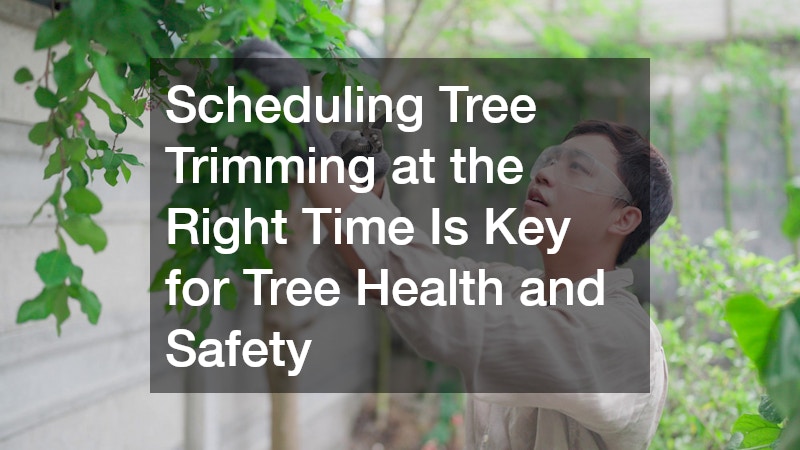Understanding the best time to schedule tree trimming services is crucial for maintaining the health and beauty of your trees. Seasonal changes, tree species, and local climate conditions all play a role in determining the optimal timing for tree trimming.
Why is Timing Important for Tree Trimming?
Impact on Tree Health
Scheduling tree trimming services at the right time significantly influences tree vitality and growth. Trimming during inappropriate seasons can lead to stress, weak growth, or even damage, which may compromise the tree’s overall health.
During certain times of the year, trees allocate energy differently, making some months more suitable for cutting back branches. For instance, trimming when a tree is actively growing might result in excessive sap loss, weakening the tree.
Timing also affects the wounds left by trimmed branches, which need to heal effectively to recover completely. Conversely, trimming during dormant seasons can minimize the risks of improper healing or disease entry through these wounds.
Prevention of Tree Diseases and Pests
Proper timing in tree trimming can play a pivotal role in preventing the spread of diseases and infestations. Many pests and pathogens are less active during colder months, which offers a safer window for trimming.
For example, trimming oak trees during warmer months can increase the risk of oak wilt, a deadly fungal disease. By scheduling trimming during late winter, homeowners can significantly reduce this risk.
Moreover, trimming can eliminate infected or pest-ridden branches before they impact the entire tree. This proactive measure ensures that potential threats are addressed during periods when trees are less susceptible.
What Are the Best Seasons for Tree Trimming?
Advantages of Winter Trimming
Many experts recommend tree trimming during the winter due to the dormant state of most trees. When trees are not actively growing, trimming incurs minimal stress, allowing for better recovery come spring.
With leaves gone, the tree’s structure is more visible, enabling precise cuts and optimal branch management. Furthermore, during winter, the absence of active growth reduces the chance of disease transmission, promoting healthier tree development.
Winter trimming also aids in freeing up resources for a productive growth season. As trees awaken, they can focus energy on new growth rather than healing wounds.
Trimming in Spring and Summer
Trimming in spring allows for the removal of dead or damaged branches affected by winter storms. However, it requires caution as entering the active growth phase might lead to excessive nutrient and water loss.
Summer trimming can be beneficial for controlling growth and shaping trees. During this time, the active flow of nutrients supports quick healing of branches, although stress from heat must be considered.
With adequate timing, summer trimming allows you to mitigate safety hazards by addressing branches that may pose risks. It’s essential, however, to avoid trimming during high stroke-risk months to prevent sun-scalding.
How Does Tree Species Affect Trimming Schedule?
Deciduous vs. Evergreen Trees
Deciduous and evergreen trees have distinct life cycles, affecting their trimming schedules. Deciduous trees, which lose their leaves annually, benefit from late winter trimming to prepare for the upcoming growth season.
Evergreen trees, retaining foliage year-round, exhibit different energy uses and may require more specific timing. Ensuring minimal stress by trimming evergreens requires consideration of the tree’s particular growth patterns.
Understanding the species-specific needs of trees aids in effective and healthy trimming. With this knowledge, you can tailor pruning activities to the tree’s unique physiological demands.
Special Considerations for Fruit Trees
Fruit trees require precise trimming schedules to promote healthy fruit production. Typically, late winter to early spring is ideal for trimming fruit trees to stimulate growth and enhance yield.
This timing coincides with dormancy, reducing the risk of disease while setting up the tree for a fruitful season. Care must be taken to avoid over-trimming, which could impact flower production and subsequent fruiting.
Considering the species and vigor level of a fruit tree is also critical. Some trees might necessitate additional mid-season pruning post-harvest for optimal health management.
What Role Does Climate Play in Tree Trimming?
Regional Climate Influences
Regional climate conditions invariably affect the timing and methods of tree trimming. In areas with temperate climates, winter months present ideal conditions for minimizing disease and pest threats during trimming.
Conversely, tropical and subtropical regions often require customized schedules due to year-round growth and potential weather extremes. Understanding local climate patterns enables better planning for seasonal shifts and potential anomalies like heat waves.
A pliable approach based on regional climate aids in maximizing tree health and minimizing unnecessary stressors. With climate-aware strategies, trees can thrive under varied environmental conditions.
Adapting to Unexpected Weather Conditions
Unexpected weather events, such as late frosts or abnormally warm days, necessitate adaptable tree trimming strategies. These anomalies may disrupt regular schedules, requiring changes to avoid compromising tree health.
Adapting to sudden weather shifts includes reassessing risks and quickly responding to damage caused by storms. Rapid response trimming post-adverse weather can prevent further damage, maintaining tree safety and vitality.
Resilient scheduling allows for cutting back when beneficial or necessary. This ensures that tree care remains consistent and effective despite unavoidable climate disruptions.
Scheduling tree trimming services at the right time of the year is crucial for promoting tree health and safety. By understanding the impact of timing, species, and climate, homeowners can make informed decisions to ensure their trees thrive year-round.


